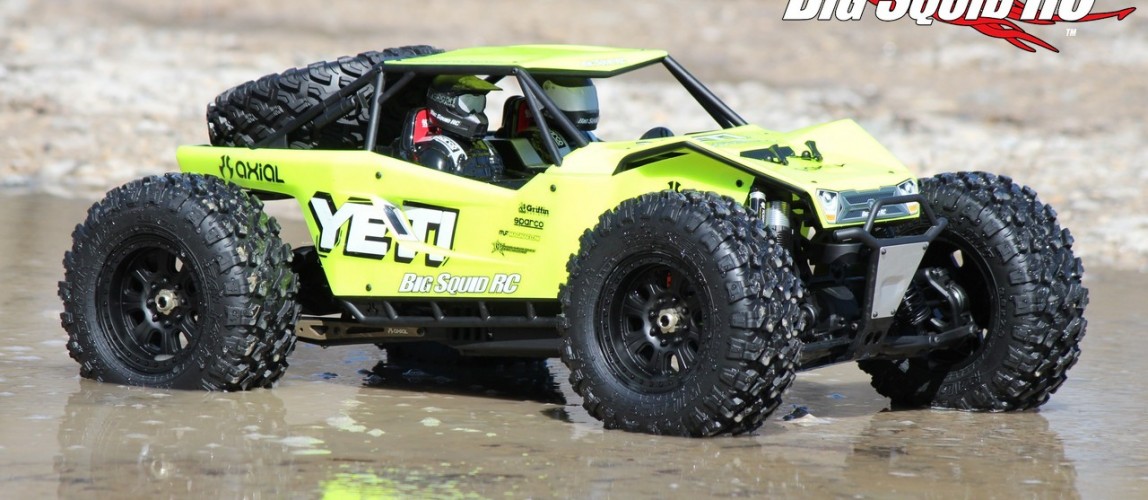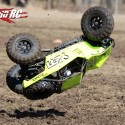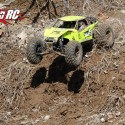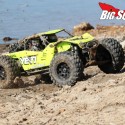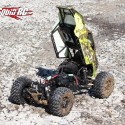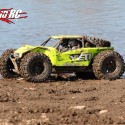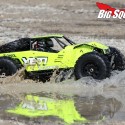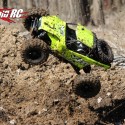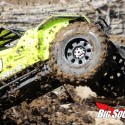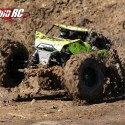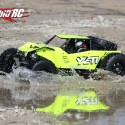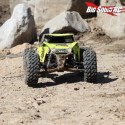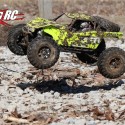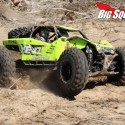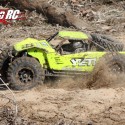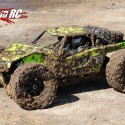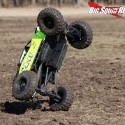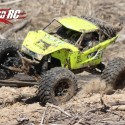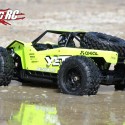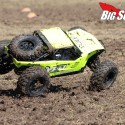The Axial Yeti XL Monster Buggy is a big, nasty, bashing machine. First introduced as a RTR, the Yeti XL is now available in Kit Form. Is the kit easy to build? Is it any different than the RTR? Is it worth your hard earned cash? Read on to find out the scoop on the Yeti XL Kit…
From: Axial Racing
Direct Link: Yeti XL Kit
Unboxing Pictures: BSRC Unboxes the Yeti XL Kit
Build Log: BSRC Builds the Yeti X KitL
Review By: Cubby
Photography By: Tim Mohr
Specs:
RTR or Kit: Kit
Age: 14+
2wd or 4wd: 4wd
Shaft or Belt: Shaft
Electric or Gas: Electric
Scale: 1/8th
Length: 25.75″
Width: 16.3″
Wheelbase: 18.5″
Weight (measured by BSRC fully ready to drive): 15 lbs
Differential: 2 gear diffs
Slipper Clutch: Yes, aluminum plates
Driveshafts: CVD style
Shocks: Aluminum bodies, oil filled
Servo Saver: In steering rack
Screws: Hex, metric
Spur/Pinion Pitch: 1M
Bearings: Full set
Tires: Axial Falken WildPeak M/T
Part Number: #AX90038
Warranty: “…free from defects in material and workmanship when new in the factory sealed box.”
Bashing Specs:
Front wheel travel: 2.8″
Rear wheel travel: 4″ (at center of axle)
Wheelie on demand: Yes
Backflip off ramps: Yes
Top Speed (measured by BSRC on 6S): 52 mph
Runtime (measured by BSRC on 4S 6500): 21 minutes
Street Price: $499
Primary Competition: While there is no direct competition for this scale monster buggy with a rear solid axle, if we had to lump it in with other vehicles it would be with 8th scale monster trucks, primarily because of its size.
What’s Needed To Complete: Paint, a motor, a speedo, a steering servo, a transmitter, a receiver, batteries, and a battery charger.
Build Quality: Hey, it’s a kit so the final build quality is completely up to you.
Test Drivers: Tim Mohr, Robbie Da’ Gangsta, Sam Da’ Noob, Iron Stomach Mike, and yours truly.
Test Venues: St Louis Dirtburners 8th scale track, Minnie Ha Ha park in Fenton MO, Cliff Cave park in St Louis MO, a skate park in Arnold MO, and a CostCo parking lot.
Set-up Notes: We ran two different power set-ups on our Yeti XL. For 4S we ran an RC Gear Shop 2150kV brushless system off of a pair of MaxAmps 2S 6500 LiPo batteries. For 6S running we installed a Castle Creations Mamba Monster with 2200kV motor off of a pair of Reedy Wolfpack 3S LiPos. For charging we used a TrakPower VR-1, while we let a Futaba S9353HV servo handle the steering duties. Duratrax paint was used on the body and a Futaba 4PX controlled the beast. Lastly, we used Castle Creation connectors on all the batteries and speedos.
Turning: The RTR version doesn’t turn well, thankfully with the kit version you can change that. So here is the scoop. The stock servo saver is too loose and it isn’t adjustable in a traditional way. We added one 2mm thick M8 washer below the servo saver spring to tighten it up. After that the servo saver still works, but is tight enough to only work when actually needed. Also, when you build the kit the manual says to use a 30mm gap in the tie-rod that goes from the servo horn to the steering rack. We found that with a 30mm gap the truck could not turn full right without the rod end hitting the servo case. We then cranked down the tie-rod to a 25mm gap. At 25 the other rod end would hit the front edge of the servo keeping it from turning full left. Thankfully, a 27.5mm space between rod ends on the servo horn tie-rod will yield full left to right. When you combine those two mods with a kick ass servo, the Yeti XL turns quite well. We found that the Futaba S9353HV (.07/272 at 6.6v) we used could easily crank the wheels lock to lock on carpet, asphalt, and on dirt.
To get down to how it really steers, the Yeti XL Kit set-up like ours had aggressive turn-in at corner entry, making it easy to traction roll at speed. The front wheels were well planted at the apex and it had good on-power steering at corner exit. It didn’t have a tiny turning radius, but it turned worlds better than the RTR version. Lastly, because of the massive torque twist on the Yeti XL, it does turn (and will always) better one way (to the right) than the other.
Jumping: The Yeti XL Kit liked to jump a bit nose low, but thanks to big power and tons of rotating mass, a squeeze of the throttle typically had no problem bringing the front end up. Other corrections in the air, like tapping the brake to the bring the nose down, were a bit more abrupt than trucks/buggies that come with a center diff. Big ruts on jump faces, even huge ruts, were relatively ignored, while landings were a bit on the bouncing side thanks to the very soft damping in the rear shocks.
Bumps/Whoops: With its huge form factor the Yeti XL was a beast in the rough. It could plow over huge dirt clods and even good sized tree branches. Its one downside was once again its soft rear damping, leading to a bumpier ride than need be.
On-Road: Even though the Yeti XL is as hardcore as they came for an off-roader, we still had a blast driving on-road with it. Yes, it does like to traction roll so you gotta take it easy in the corners, but otherwise it’s a blast to haul flat out through parking lots and to jump curbs with.
Grass: The Yeti XL is a beast in the grass, arguably the best 8th scaler on the market for such driving. It chews up and spits out short grass, while plowing right over the moderately tall stuff. Basically, if you do a lot of driving at the city park or in your backyard, the Yeti XL is top notch when it comes to the grass driving. Furthermore… on those long trail drives when you have to drive over sections of grass, it can blast through tall grass that leaves smaller scaled vehicles dead in their tracks.
Tires: We were HUGE fans of the included tires. They have an aggressive tread pattern and are molded out of soft rubber which give loads of traction on just about every surface. Their scale appearance is top notch as well.
Broken Parts: We got in a lot of time with the Yeti XL Kit with not much breakage. We popped the rear driveshaft when landing a big jump WFO on 6S and we stripped out a front wheel when we didn’t notice it was loose, otherwise we bashed it fairly hard without breaking many parts.
Misc Notes:
It took about 16 hours to do the entire build from start to finish, which is about normal for a kit of its complexity. We didn’t run into any major problems during the build, when you build yours just take your time and pay very close attention to the illustrations.
The included sway bar does help to cut down torque twist on the chassis, but it doesn’t eliminate it completely.
The manual doesn’t really give base settings, but we ended up with 1 degree toe-out and about 2 degrees of negative camber on the front wheels. For ride height we set the front bones to slightly above level, with the chassis level to the ground.
As much as we love the Yeti XL, we have two big gripes with it. The battery boxes are a massive PITA to get the pins in, and the tilt back body loves to pop down at the worst possible time (when you are wrenching) to smack your hand and/or face. Seriously, we absolutely dread opening up the battery compartment because it is such a pain to get closed again. You can prop something inside the body or in the rear to hold it up to solve that one.
One of the upgrades the Kit gets over the RTR is the addition of 17mm wheel hexes, a very welcome change. The other small upgrades (like the sway bar) over the RTR do make the kit version a better overall machine than the RTR. If you’ve got the electronics already sitting in your pit box, getting the Kit version is a no-brainer plus you’ll save $200 off the price of the RTR.
There are no drain holes in the chassis to let water out. Sure, they are easy enough to drill yourself, but stock you’ll find water just sitting in the chassis for no good reason.
The Yeti XL likes to stretch its legs. If you drive primarily in small areas, go for the normal sized Yeti. If you drive in larger areas, pop for the XL.
After months and months and months of driving the XL we have truly found where it is at its best. Sure, it can bash in the park quite well, but where it excels is true off-road exploring. For example, go to a local park then get off the beaten path. Or head down the river, or head up the side of a mountain. The enormous size of the Yeti XL, and the way it is set-up with a sold rear axle, allow it to traverse some legitimately gnarly terrain. Sure, you can trail drive with a “normal” 10th scale 2.2/1.9/1.55 truck, but inevitably those size of trucks quickly find terrain they just can’t get over. That isn’t the case with the Yeti XL, and that is why it truly shines, it can get over tree branches/large rocks/rutted hills that 10th scalers can’t even dream of clearing. To boil it down, the Yeti XL makes a much larger part of your local park enjoyable.
Shall we talk about size for a minute? If you’ve never seen one in person the Yeti XL is absolutely HUGE. Its tires are similar in size to those on a 1/5th scale HPI Baja 5B and it pretty much dwarfs most “normal” size rcs.
Best Mods: Thicker oil in the rear shocks and make sure to set the steering up right (find in the “Turning” area above).
Summary:
A = Outstanding/Best in Class, B = Above Average, C = Average, D = Below Average, F = Horrific
Time To Bash: B No, building a kit isn’t the fastest way to get bashing, but based on building other kits the Yeti XL went together fine.
Workability: C Watch your hands folks, that neat looking tilt body is after your fingers.
Car Show Rating: A The Yeti XL Kit has an amazing amount of details from front to rear. Its cage and body look cool, its shocks are ultra-trick, and its wheels and tires are freak’n awesome. Absolutely top notch.
Bash-A-Bility: B Axial beefed the Yeti XL in the right areas, we broke very few parts.
Fun Factor: A The Yeti XL Kit is incredible fun to bash at the local park and fun to do speed passes on pavement with, but it really shines when you hardcore off-road it.
Handling: B Provided that you install a decent servo, the Kit version can turn circles around the RTR version and it generally eats up all sorts of off-road nastiness.
Value: B $499 isn’t cheap, nor are the electronics it takes to get it up and going, but when finished it gives a heck of a lot of performance for the money.
Parts Availability: C You won’t find many Yeti XL parts on the shelves at your LHS but replacement parts are easily found on-line.
BigSquid Rating: B The Yeti XL Kit is definitely a better buggy than the RTR. If you are a hardcore basher, the Yeti XL Kit can do a roof jump, then a 50 mph speed run, then blast around your cul-de-sac, then chew up the grass in your backyard like nothing else on the market. If you are a scale/trail enthusiast, it looks the gnar-core part and can go places that other trail machines can’t even dream about. Should you cut the check for one? Absolutely! The Yeti XL Kit is a great all around bash machine.

